new posts in all blogs
Viewing: Blog Posts Tagged with: book blog tour, Most Recent at Top [Help]
Results 1 - 18 of 18
How to use this Page
You are viewing the most recent posts tagged with the words: book blog tour in the JacketFlap blog reader. What is a tag? Think of a tag as a keyword or category label. Tags can both help you find posts on JacketFlap.com as well as provide an easy way for you to "remember" and classify posts for later recall. Try adding a tag yourself by clicking "Add a tag" below a post's header. Scroll down through the list of Recent Posts in the left column and click on a post title that sounds interesting. You can view all posts from a specific blog by clicking the Blog name in the right column, or you can click a 'More Posts from this Blog' link in any individual post.
I have wrestled with this for a while, but it is time for Tweendom to slowly sink into the sunset. It has been a wonderful 10 years (TEN YEARS!), and I've really enjoyed blogging and getting to know so many of you in real life!
I will keep reading tween books, as this is really my sweet spot, and feel free to follow me over on goodreads (Stacy268) to see what I've been up to.
Instead of totally shutting this blog down, I am going to leave it here so that folks can find some great titles for those middle schoolers in their lives.
Thanks for following and happy reading!

Sometimes writing feels like running a marathon. You write, write, write, lather, rinse, and repeat. You develop your plot, you explore characters, you get in your 1000 words or x-number of pages per day, and the end feels so very far away. In fact, it feels like you might never reach it. My current WIP has felt like a particularly long marathon. I’ve been going to school, so the normal “get to the end” trajectory has been peppered with revisions, feedback, and more revisions. All of which has made me a better writer. But part of me was starting to believe I would never finish anything again.
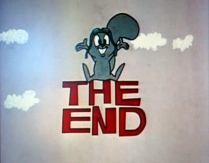 Don’t get too excited, I haven’t finished this book — YET. But the end is in sight. I can see it. Finally!
Don’t get too excited, I haven’t finished this book — YET. But the end is in sight. I can see it. Finally!
My lack of blog-posts have therefore been in pursuit of the ever elusive ending. So please bear with me as I find my final wind and race to “The End!”
In honor of this final sprint, I offer these lovely words of wisdom on endings:
“There is no real ending. It’s just the place where you stop the story.” – Frank Herbert
“Let your characters actions and situations reveal the significance of your ending. Don’t explain what your story means or what your characters have learned.” – Scott Eddleston
“What rings and resounds at the end of a novel is not just physical. What moves us is not just characters, images and events…we are moved by the increasing connectedness of things, ultimately a connectedness of values.” – John Gardner
“When a symphony is over we feel the notes and tunes composing it have been liberated, they have found in the rhythm of the whole their individual freedom. Cannot the novel be like that?…Music, though it does not employ human beings, though it is governed by intricate laws, nevertheless does offer in its final expression a type of beauty which fiction might achieve in its own way. Expansion. That is the idea the novelist must cling to. Not completion.” – E.M. Forster
As you all run your marathons and reach for the end, may your journey (and your protagonist’s journey) find expansion in the space of reaching your goals! Happy writing everyone. I’ll be back when I’ve finished this draft.



DearEditor.com is hosting a “Revision Week” in which she interviews various authors about their revision process.
Today, Robin LaFevers answers the question, “When it is sent to the printer. Seriously. I could fiddle and tweak forever. In fact, I have been known to tweak and edit on a printed copy of the book before doing a reading. But there is a point where you aren’t necessarily making it better—just making it different. Or so I try to tell myself.”
It’s true.
We could tweak, edit, fiddle until the earth ended and still not be satisfied. We are perfectionists.
But there are some definite points at which you should stop for a while, or stop for good.
- Stop and Let it Rest. After a first draft and after each major revision, if you
have the luxury, let the manuscript sit for a month or longer. It’s at this point that there are two manuscripts: the one you dreamed of writing and the one you actually wrote. You need some perspective, some time to SEE that there are two. Otherwise, you only see the one you intended to write, not the words you actually put on paper. Take a break. Come back with a fresh eye toward making the two manuscripts match up better.
- When you Don’t Know What Else to Do. There are times, when I finish a draft that I think, “I’ve done everything I know to do.” That’s when I need feedback from a critique group or an editor. I can only do the best I can do at any particular point in time. Feedback can shove me off my comfort zone, can make me uncomfortable with some aspect of the story, can get me back revising. But sometimes, I can do nothing more until I get feedback.

- Move from Critique Group Input to Editorial Input. There’s definitely a time to thank your critique group and depend on editorial input. The critique group will get you into an editor’s hands; then, you must please only two people, you and the editor. Doesn’t matter at that point if the critique group doesn’t agree: they aren’t backing up their opinion with cash. At this point, I don’t get feedback from the group. When the editor says it’s done, it’s done.
- Deadline. Sometimes, there’s an external impetus to stop. Of course, you must stop when it goes to press. Not always the best stopping point, but the realities of writing sometime dictate this. Work fast and furious as long as you can. Then let it go.
- Please Myself. As the author, though, I am the first and only audience in some ways. I want to please myself and make sure this story is the absolute best I can make it. I quit only when I am sure I can do no better. Period. No feedback budges me. No cooling-off period budges me. Nope. When I can do no more, it’s time to quit. Stop second-guessing, stop whining that it’s not perfect but I don’t know why it’s not perfect. Let it go. Stop. Do not revise again.
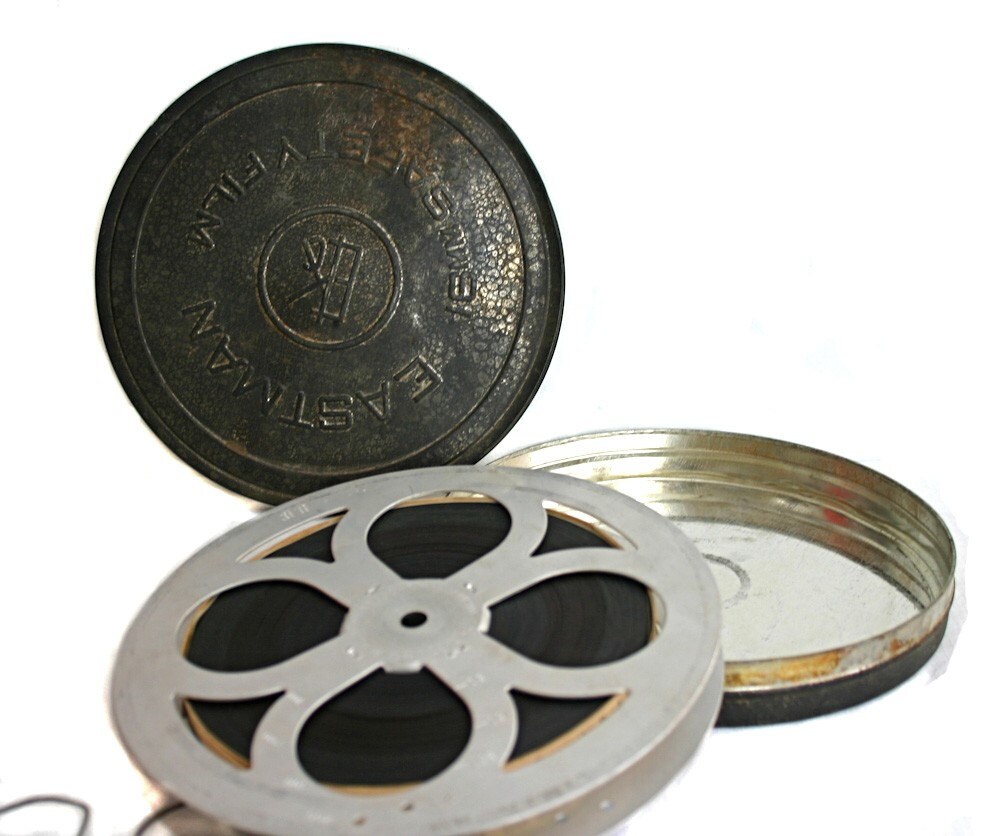 And by "canned" I mean the first draft of In the Memory House is DONE.
And by "canned" I mean the first draft of In the Memory House is DONE.
Whew.
It's a slim book at only 60K, but those words came with a price: months of writing and rewriting and several characters who will never be the same.
Some may have even been harmed in the drafting of this book. *sad face*
On to a short story I've been itching to write, and then edits and the next book and the next and the next...
Happy writing.
 by David LaRochelle
by David LaRochelle
In my day-to-day life I’m a dreary, straight-laced stickler for rules. I’m obsessively punctual with my rent. I always wear my seatbelt. And I’d never dream of going through the Express Lane at the grocery store with more than fifteen items in my cart.
But when it comes to writing picture books, I’m proud to be a rule-breaking outlaw.
 Who says a picture book needs to be told from start to finish? My fairy tale The End is told in reverse chronological order, from end to middle to beginning.
Who says a picture book needs to be told from start to finish? My fairy tale The End is told in reverse chronological order, from end to middle to beginning.
In fact, who says a picture book needs a traditional beginning, middle, and end at all? My latest book, 1 + 1 = 5 And Other Unlikely Additions, is simply a collection of surprising (but plausible) math facts. 1 + 1 = 3? 1 unicorn + 1 goat = 3 horns! 1 + 1 = 6? 1 duet + 1 quartet = 6 musicians! Who would have guessed that a list of equations could make a successful children’s book, but it works.
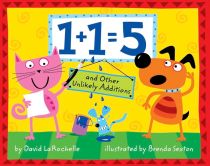 Which brings me to my writing tip for today: forget about the rule that says a good book needs a plot with a character and problem and solution. Today, just make a list. The Top Ten Ways to Avoid Doing the Dishes. Reasons Why I Should Have a Horse. My Favorite Things to Do with Peas Instead of Eating Them. You decide on the topic.
Which brings me to my writing tip for today: forget about the rule that says a good book needs a plot with a character and problem and solution. Today, just make a list. The Top Ten Ways to Avoid Doing the Dishes. Reasons Why I Should Have a Horse. My Favorite Things to Do with Peas Instead of Eating Them. You decide on the topic.
Come to think of it, maybe I’m not such a rule-breaker after all. There are plenty of wonderful picture books which are, at their hearts, simply lists:
Jane Yolen’s humorous How Do Dinosaurs Say Goodnight?
Lauren Stringer’s clever and beautiful Winter is the Warmest Season
Judith Viorst’s classic Alexander and the Terrible, Horrible, No Good, Very Bad Day
Of course successful list books like these are more than a recitation of boring items. They resonate with a child’s emotions, shine with beautiful language, explode with humor, or invite the reader to look at the world in a new way.
And you can write a memorable children’s book, too! Just pick up your pencil and start making a list.
David LaRochelle has been creating books for young people since 1988. His next picture book, The Haunted Hamburger and Other Ghostly Stories, illustrated by Paul Meisel, will be released by Dutton in 2011. He lives in White Bear Lake, Minnesota and is currently catching his breath after a busy month of carving pumpkins, some of which can be viewed at his website www.davidlarochelle.net.


 10 Comments on PiBoIdMo Day 2: Be a Rule-Breaking Outlaw like David LaRochelle, last added: 11/2/2010
10 Comments on PiBoIdMo Day 2: Be a Rule-Breaking Outlaw like David LaRochelle, last added: 11/2/2010
Anyone want an adverb? I have thousands of them in Theatre. In fact take out the adverbs and the wee book adds up to about 40,000 words.
I also have two other words that you can borrow if you want:
THE END
It's Paco time!
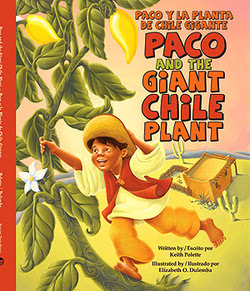
New this week: Paco and the Giant Chili Plant, written by Keith Polette, published by Raven Tree Press, and illustrated by Elizabeth O. Dulemba.
To celebrate, Elizabeth's blogging author/illustrator buddies are sending her on a book blog tour. For my stop in the tour, I've asked her 6 questions. Read her answers, below, and then check out the other station stops in her tour.
And buy her book!
---------------------------
1. Which title do you take more pride in, author or illustrator?
---------------------------
I was an illustrator first, so it's the title I'm most comfortable with, however, I probably take it for granted. The author tag is new and still somewhat untested. Although I've sold many articles, a short story, a poem, have won honorable mention in several writing contests and am writing my second novel, I have yet to see my name on the cover of a published book as author. So that's what I covet the most right now.

---------------------------
2. I admire that you took a lot of time to develop your work, a few years ago, to get it ready to submit to publishers. That takes patience and persistence. Care to share how you did it?
---------------------------
Oh, I was sending work out while I tried to develop my style, don't get me wrong! I just hadn't found my voice yet and there wasn't much interest until I did. To find it, I experimented with everything: acrylics, oils, gouache, markers, colored pencils, you name it. The supplies are scattered around my office . . . somewhere. It wasn't until I went back to the computer and the software program, Painter, that I sprouted wings. (I'd dabbled with Painter for years, but frankly, computers weren't up to the task until just a few years ago. It's a behemoth of a program.)

---------------------------
3. Describe your best speaking gig so far.
---------------------------
Hands down, the Decatur Book Festival. Now heading into its third year, it started up right after I moved to the area. The owner of my favorite independent bookstore, Little Shop of Stories, is in charge of the children's stage and has been so supportive of my career. That first year, I read GLITTER GIRL AND THE CRAZY CHEESE to a crowd of hundreds under the children's tent - what a thrill!
---------------------------
4. What competes for your time, and how do you manage to give your writing and illustration work the time it needs?
---------------------------
I just work my tail off, no way around it. I have two muses fighting for 100% of my time and it's tough to keep them appeased.
---------------------------
5. What are your goals for your work?
---------------------------
I always want to produce the absolutely best work I can, which can be challenging when I'm not given enough time or have too much on my plate. But I got into children's books to create inspired work, work that attempts to be in the same league with that of my heroes (children's book illustrators). My goal is for my work to entrance and transport the viewer to magical places.

---------------------------
6. Now that Paco's out, what are you working on next? ---------------------------
Lots! I'm writing my second novel (the first is with my agent). I'm illustrating the second two books in a parental aid picture book series - I also illustrated the first two which come out this June. I'm finishing up a few coloring book covers and writing more picture book stories. And of course, I've got lots of engagements lined up to celebrate Paco! I can't wait! (My calendar of events: http://dulemba.com/index_schedule.html ).

In keeping with my fellow bloggers' recipe offerings, here's mine:
Five Year Old Quesadillas (pronounced Kay-sah-DEE-yahs)
(so named because they're easy enough for a 5-year-old to make -- not because they're old ;)
1. Lay a flour tortilla on a glass dish.
2. Sprinkle it with about 4 tablespoons of grated cheese, more or less to taste. Grated cheddar, mozzarella, Monterey Jack or a taco blend all work well.
3. Top with another flour tortilla.
4. Zap it in the microwave for 20 seconds or until the cheese is melted.
5. Remove from oven, let cool, and slice it into pie-wedges using a pizza cutter.
This is my 5-year-old grandson's favorite recipe, at the moment.
To read the rest of Elizabeth's interviews and find a few more recipes, check out these blogs:
Monday: Kim Norman's Stone Stoop! Kim is the author of "Jack of all Tails" and shares a great recipe for Tasty Tortilla Snowflakes!!
Tuesday: Barbara Johansen Newman's Cat n' Jammers Studio. Barb wrote and illustrated "Tex & Sugar."
Wednesday: Janee Trasler's Art & Soul. Janee's latest book is "Ghost Eats It All!"
Thursday: Ruth McNally Barshaw, creator of "Ellie McDoodle: Have Pen, Will Travel!" (Elizabeth says: If you like "Diary of a Whimpy Kid," you'll love Ellie! -- thanks, Elizabeth)
Friday: Kerry Madden, author of "Jessie's Mountain," the thrid installment in her Maggie Valley trilogy (read about it here.)
Saturday: Sarah Dillard, illustrator of "Tightrope Poppy" and author/illustrator of the forthcoming "Perfectly Arugula!"
And -- check out Elizabeth's site for more of her luminous art-- like this piece:

Writing scenes for The End can be more uplifting than writing scenes in The Middle.
Think of the Middle as the tunnel of darkness, fraught with antagonists of all sorts. The Crisis, the high-point of the Middle, is the dark night of the soul, hitting bottom, when the protagonist becomes conscious of who she really is, or what she has been avoiding or denying. A light snaps on, and thus begins the process of transformation.
In the End, the protagonist still has foes to confront and overcome. Only now, she is armed with a new understanding of herself. For the first time, her goal comes into focus.
The Climax at the End (1/4) serves as the light at the end of the tunnel. The protagonist moves toward the light -- one step forward toward the ultimate transformation, three steps back, a fight for a couple of steps, being beat backwards.
The Climax spotlights the character in full transformation demonstrating the necessary new skill or personality, gift or action.
The Climax is the crowning glory of the entire project. The Climax is where protagonist "shows" in scene her acting in a transformed way -- in a way she could not have acted in any other part of the story because she first needed to experience everything she does in the book to get to the final stage.
Ask yourself what scene will most dramatically show her demonstrating her transformed self?
The Resolution ties everything up. If the story resonates with thematic significance the reader is left to ponder the deeper meaning.
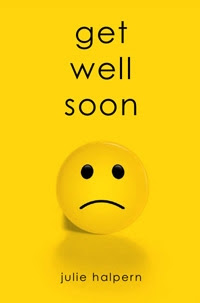
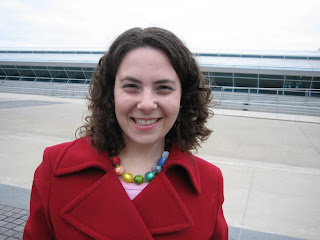
Please welcome author Julie Halpern! Julie's YA novel, Get Well Soon, was nominated for a 2008 ALA Quick Pick. Congratulations, Julie! :)
Bio:
A native to the Chicago suburbs, I have been a school librarian for the past seven years. I live with my sweetheart husband, illustrator Matthew Cordell, and our gloriously large Siamese cat, Tobin. In my spare time I like to read, watch TV, play Sims 2, and travel.
Summary:
Anna Bloom doesn't know what happened, but somehow she ended hospitalized at Lakeland for depression. Through laugh out loud funny letters home to her best friend, Anna describes her experiences in a mental hospital, complete with kooky friends, oblivious adults, and even a little romance, and ends up learning more about herself than she ever expected.
What inspired you to write Get Well Soon?
The book is based on my own hospitalization for depression in high school, although throughout the editing process a lot of the details have become fictionalized. I always thought the experience would make a great book, filled with interesting characters and bizarre situations. And since I read so much YA, and so much of it is dark and depressing, I thought it would be nice to write a funny book about a not so funny topic.
Tell us about your main character. Are you like him or her?
I am definitely like her, although I’m not as sarcastic. And since I’m older and have had many more life experiences than Anna, I think I’m a lot more confident. But her experience was very close to my own experience in the hospital, with a few fictional details thrown in.
What is your writing process? Are you an outliner or not?
I don’t really outline. Sometimes I make a list of things I want to include in the story. Get Well Soon had a lot of events that had to happen in a very specific amount of time (three weeks), so I wrote out sort of a day planner, where I plugged in big events on specific days. I hand write the first draft of my novels because I write much faster than I type, and I like to flip back, scratch out, etc. Then I have to type up the whole thing, which is my least favorite part, and I revise as I go. Then I print it up, revise it again, and then it’s ready for someone else’s eyes.
What’s your favorite time of the day to write?
In high school, I loved to write at night because no one else was awake. But now I fall asleep around 9:30 every night, so that’s out of the question. I can pretty much write at any time of day, as long as I just sit myself down and make myself do it.
What do you hope readers will gain from reading Get Well Soon?
I’d like readers who have their own battles with depression to gain some sort of happiness from the book because it’s funny and because it lets them know they’re not alone. And I hope that people will look at depression and hospitalization a little differently, like maybe it’s more normal than they think. I have heard from quite a few people that have been or know someone who has been hospitalized, teens dealing with depression, as well as teens just looking for a funny book. I love hearing from the readers because it makes me feel like I did something right.
Writing can be filled with rejection. How do you handle that?
Not too well, although luckily I have a day job that I love and don’t have time to write millions of novels and wait for millions of rejections. Get Well Soon only went through a couple of rejections, and I just knew when I found my editor that we were meant to work together. She is now helping me revise my newest novel.
What characters do you most admire in your book and why?
I admire Matt O. because he’s been through some tragic stuff but still continues to be human and funny. And I completely admire Justin for seeing past unrealistic beauty standards for women and liking Anna the way she is.
What’s your next project?
My next book was originally called Roll for Initiative (a Dungeons and Dragons reference), but my editor and I are working on a new title (although I have some students who are fighting to keep the title). It’s a teen novel about how best friends aren’t always the best people for you and how nerds can be cool. Or something like that. I’m waiting for my editor’s first big round of notes. Always a little scary, but she did say she loved it and she swears she doesn’t say that to everyone. I asked.
Website: http://www.juliehalpern.com
Blog: http://www.juliehalpern.com/blog
Link to Amazon: http://www.amazon.com/Get-Well-Soon-Julie-Halpern/dp/0312367953/ref=pd_bbs_sr_1?ie=UTF8&s=books&qid=1200429268&sr=8-1
**Julie's giving away one signed copy of Get Well Soon and a frowny face button! To enter, leave a comment here, on LJ or both places by 9pm on Sunday night.**

By: Martha Alderson, M.A.,
on 1/7/2008
Blog:
Plot Whisperer for Writers and Readers
(
Login to Add to MyJacketFlap)
JacketFlap tags:
Dramatic Action,
Character Emotional Development,
The End,
The Middle,
The Beginning,
Dramatic Action,
The End,
The Middle,
The Beginning,
Character Emotional Development,
Add a tag
I have purchased and read your book "Blockbuster plots pure and simple" and I still don't understand. I'm starting with a basic logline for a plot and don't know how you come up with scenes if you don't even know what the story is about. It would seem to me that in order to create scenes or follow the plot planner portion of the book you need to know more about how the story is going to unfold than you know when you just get the idea. It feels like there is a step missing between the initial idea and being able to come up with scenes.
What am I missing?? Please help!
Thanks,
Muriel
Dear Muriel,
Often, with a firm understanding of the Universal Story form and the natural trajectory of a story, writers can better come up with scenes needed to create a story.
If character most intriques you, start with the character emotional development profile (info can be found in BBP, on the website, and in entries below).
If dramatic action ideas bubble forth, start with the action.
Study the three biggest scenes in a story: The End of the Beginning, The Crisis, and the Climax (in the second half of BBP -- Plot Planner portion of the book -- also, the blog has info on these three critical scenes below).
See if you can visualize any of those scenes in your story.
How do you get your character from the beginning to the End of the Beginning?
What events are you interested in exploring, writing?
Do you plan to use any true historical events?
How can those events work into creating one of the three major plot lines (examples are in the book and below)
or....
Start with whatever you've got. Write that in scene. Then ask yourself: because that happens, what happens next.... Write that scene. Then ask yourself again -- if that happens, what happens next?
Hope this helps.
I'll put the word out for other writers to give their ideas as well.
Great good luck.
Sincerely,
Martha
~~~ post under construction~~~
Read on for an interview with Karen Lee, author and illustrator, as part of her friends' Book Blog Tour.
Hi, Karen! I'm so excited about your newest book, My Even Day, and excited to help you along on your book blog tour.
1. You are from a family with a bunch of kids born in a short number of years, just like me. How did that affect your art? As second of five, do you feel like an oldest kid or a middle kid?
I think both nature and nurture have had their influence on how I became an illustrator. I want to point out here that even as a very young child it was all about illustration for me – not fine art. I never wanted to be a fine artist and the reason I didn’t go to the nearby Cleveland Institute of Art is that it is a fine art school. It wasn’t until I discovered CCAD that I knew that was where I belonged.
I feel like the oldest. My brother is one year older than me and then I have stair stepping sisters, so I was leader of the girls (leader of all until my brother got taller than me in high school). I still feel that big sister need to round up my chicks and herd them where they need to go, not that I am a natural leader, just a chick herder.
2. What kind of art did you like to do as a kid?
Has any part of your art remained constant?
I was a very typical kid. I enjoyed art and it was always very exciting for me, but I wasn’t particularly driven. I went through the horse profile stage like every other girl. I had a pretty dynamite high school art experience and was able to try lots of different things. Drawing and painting have remained the constant and the work always looks like I did it – even when I look back on older work, there is something soft and Karenish about the work. That’s sort of frustrating but it’s also what contributes to the style.
3. You're married to an artist! That must make for some interesting
dinner table conversations at your house. How do you keep your work separate? How do you keep from morphing with him into a third, between-the-two sort of entity?
Yes! Our conversations can be pretty fun. I love being married to Tim the guy, but I am really fortunate to be married to Tim the artist. We have always kept each other passionate about art and that is precious. He turns me on to artists outside the children’s publishing world and that keeps me more in tune with what is happening in the broader world of illustration. I don’t think we keep our work separate and I’m glad.
We have had several overlapping clients over the years – one of his clients will call me not knowing that we are married, and the other way around. Although our work is different there is definitely an influence on each other. I am actually ready to morph with him now (oh, how he loves to hear that!). It took some maturity on my part to be able to think of working with him on something and we are beginning to. He is much more adventurous in his art than I am and I want to tap into his bravery, lean on him a little. And I think the art could be pretty spectacular!
What we don’t do is critique each other. We need to stay married and it is too hard to not take criticism personally.
4. Describe the perfect career path for you.
I want to continue to illustrate other people’s writing. I want to be offered work that challenges me to continue to move forward rather than stay in place. I want to continue to write and gain the confidence and skills to create something enduring and universal. I want to be able to delight in the work I am doing (as I am now). I don’t want to map out where the path ends up but find my way as I go. When I look back at where I’ve come from I am grateful that it led me here and I have certainly guided it, butI have also allowed for synchronicity and I know that will influence what becomes of me next.
5. Are you active in SCBWI or any other writer groups? What kind of stuff you do for them? And what do you get out of it?
Yes! I am very active in the Society of Children’s Book Writers and Illustrators here in the Carolinas. I am the Illustration Coordinator for our chapter – which really means I am the head cheerleader and wrangler for the artists in the organization. I coordinate the art for our quarterly newsletter and occasionally provide articles. We are having our 15th annual fall conference beginning this Friday and I have been very involved in the planning for that. I love this organization and as much as I have put into it, I have received back in spades. It was through my first conferences and the SCBWI online discussion board that I learned the fundamentals of both the art of writing and illustrating for children, and then the business side of the profession. I entered contests (and won), found my publisher, found both online and local critique groups, and most importantly I found myself. I feel like I have a close circle of friends that I can count on, and a larger community that I can be inspired by.
6. You're only 29. Barely out of school and already making a name for yourself. What's different than what you expected, at this stage in the publishing game? What surprised you? What most pleases you?
Ha ha – yeah, 29. The real story is that I spent fifteen years doing storyboards in advertising and after I had both my kids I was exposed to children’s publishing for the first time. I decided to begin building my children’s portfolio when my youngest was two – and now she’s ten. So eight years is no meteoric rise. That is what I didn’t expect. I was shocked at how little I knew about creating effective picture book art, and then how long it took to have someone take the risk of signing me to do a book.
What pleases me? After years of being frustrated with my artwork almost all the time, I am now frustrated with it less than half the time. So for me the process has become the most fun. I love the early concepting phases and all the excitement that brings as ideas come together. I love drawing, I love painting. I love showing the finished result to people and seeing them react to it.
Read Karen's blog here.
Stay tuned for some art by Karen. I LOVE her work and will upload some later today....
--------------------------------------------------------------------------------
Here's the rest of the book blog tour:
Monday: Elizabeth O. Dulemba -
http://dulemba.com/2007/09/blog-book-tour-for-karen-lee.html
Tuesday: Kim Norman -
http://stonestoop.blogspot.com/2007/09/truly-odd-guest.html
Wednesday: here! Ruth McNally Barshaw -
http://elliemcdoodle.blogspot.com/
Thursday: Barbara Johansen Newman -
http://www.johansennewman.typepad.com/
Friday: Dotti Enderle -
http://blog.myspace.com/dottienderle
Saturday: Kerry Madden -
http://mountainmist.livejournal.com/

By: Martha Alderson, M.A.,
on 8/14/2007
Blog:
Plot Whisperer for Writers and Readers
(
Login to Add to MyJacketFlap)
JacketFlap tags:
The End,
The Middle,
The Beginning,
Crisis,
Climax,
Readers,
Crisis,
The End,
Climax,
The Middle,
The Beginning,
Add a tag
We as writers may start out writing just for ourselves, but even for those who are the most resistant to admit it, we each long for a readership to enjoy our projects.
Once a writer embraces that truth, our relationship to our writing changes.
One way to consider your readers or audience is to get closer to yourself. What kinds of writing do you like? How does your favorite author begin their stories? In scene or in summary? How do your scenes compare to theirs in terms of complexity, interest, excitement, character development, and truth?
What constitutes the Beginning, the Middle and the End of their projects? Can you detect what launches the character(s) into the heart of the story world towards the end of the Beginning? Does the Crisis reveal anything about the character to the his or herself or does the highest point in the story so far function only on the Dramatic Action level alone? How does the Climax show the character doing something they could not have done at the beginning of the story? Is there Thematic Significance to their writing? Is there to yours?
One of the greatest personal benefits of writing is the opportunity to dig deep for our own individual truth. The first draft for many writers skims the surface as we look for meaning and conflict shown in scene and how the characters will show their transformatio over time. Often, what we write in these first drafts is what we've heard before or learned from our family and friends, in school, and through our own reading and the news.
But once we read what we have written, we immediately sense when something does not ring true. There is no better way to learn what is true for us and what is not, than to read our words ourselves first.
As I stated in my plot book for writers, Blockbuster Plots Pure & Simple, my hope for you and for me is that our search for the truth through our writing remains active and honored. We dig for the truth not only for ourselves, but for our future audience as well.
We each share the need to be heard.
We each have something vital to offer.
My friend Kim Norman has a book out today.
Congratulations, Kim!
Please clear a path while I sing.
:::soft, sweet, clear voice:::
Happy birthday to you,
:::a little louder:::
Happy Birthday To Youuu,
:::picking up steam:::
HAPPY BIRTHDAY DEAR KIM'S BOOOK,
:::screeching now:::
H A P P Y
B I R T H D A Y
T O O O O O O
Y O U U U U !!!
:::curtsying:::
My friend Kerry Madden has a new book out: Louisiana's Song.
Since she has so much interesting information to give and it couldn't possibly all fit into one interview, I'm helping host her for a book tour through several blogs.
Visit the other blogs
Elizabeth Dulemba
Dotti Enderle
Alan Gratz
Kim Norman
and also read the interview below for a fascinating look behind the scenes in Kerry Madden's gentle world of writing.
- Kerry, please describe for us the world of Gentle's Holler.
Gentle's Holler, along with Louisiana's Song and Jessie's Mountain, the two companion novels are set in the Great Smoky Mountains of Western North Carolina in the town of Maggie Valley.
The Weems family lives in a holler up Fie Top off Highway 19 between Cherokee and Canton near Waynesville. The books are set in 1962-64 around when GHOST TOWN IN THE SKY opened (1961).
They are a family of ten kids who live without a television even though it's the 1960s. Their daddy is hoping to hit it big with a banjo hit. Their mother holds the family together as best she can and then Grandma Horace comes to visit.
I wanted to write a novel with love - and though these kids bicker and fight and get in trouble, they love each other and they absolutely want to explore world through art and music.
- How do you balance your kids' very different needs, with your writing career?
It's a huge balance, but this year is easier - our son is a freshman in college - so we just have two kids at home...It's been tricky all along though.
My husband, Kiffen, has always been a great support, taking the kids off or cooking dinner or cleaning. (Our house is so messy though, honestly, and cluttered.)
I write when they're in school, and I try to go to everything that they do - plays, sports, gigs etc. When they were babies, I wrote during their naps (nothing I wrote was much good, but I was needing to practice)...I used to write on weekends.
I'm very disciplined, and I feel like the world will end if I miss a deadline.
And from the very beginning, I didn't want to tell people I was writing a novel and then not do it. But it is a balance.
My kids are my editors and inspirations. So I think they feel part of it - they've watched it grow from nothing.
- I love that your website says you're an explorer. Can you tell us more about that?
I grew up in ten states because of my father's football coaching career, and even though I hated moving as a child, it gave me a sense of adventure that lingers to this day. I love going to new places to explore.
Our first year of marriage in 1987 was teaching English at Ningbo University in China - we both wanted an adventure before real life loomed, and after our time teaching we took the Trans-Siberian home from Beijing to Berlin.
When our children were young, we took the kids on cross-country roadtrips twice, and it was hard, but amazing - I wanted to instill in them the same longing for exploration and adventures.
A few weeks ago, I went with my sister to Monroeville, Alabama to explore Harper Lee's and Truman Capote's hometown - I love meeting new people and listening to their stories.
When I teach writing workshops, I tell kids to have adventures and explore the world! I also lived in Manchester, England my junior year in college, and I always tell young writers/explorers to study overseas.
- How do you handle the balancing act of basing your story on a real person versus respecting her sense of privacy? Do you tiptoe a lot? Is your sister in law proud to be an inspiration for your book? How would you handle it differently if the central story were a negative one?
Well, Tomi inspired the character when I first started writing the book, but I think she'd be the first to agree, she is not really Livy Two Weems.
I don't have to tiptoe, though, because she's proud of the book, and I'm so proud of her music. I wish I could market her voice and songs right off my website. She hasn't read the next two, but she's always been such a support and she knows the books are written with love. I have done writing workshops at a school where she teaches an afterschool program in Nashville. I love her music so much, and she's an artist who believes in other artists.
If it were a negative portrayal, I'd probably not mention the inspiration. I'd lay low. In OFFSIDES, my father inspired the football coach (tough-talking, cussing, ambitious, insensitive, driven and yet loving) and I was terrified of him reading it...After he finished the book, he said, "Took me six months and a lot of scotch to read that sucker. I get to write the disclaimer. But I'm proud.)
- How has your life changed with the success of your writing?
My life has not changed really. I am so relieved to have books published, because there was such a dryspell of just bad writing and rejections - and I thought - what if I never publish again? It was relatively easy to get my first novel, OFFSIDES published, but it was nine years before GENTLE'S HOLLER came out.
I love the opportunties that these Smoky Mountain novels have given me - meeting so many kids, librarians, and teachers...working with a wonderful editor and agent...so yes, that aspect of my life has changed.
I am not nearly as scared as I used to be in front of audience, and I love telling mountain stories.
We have never bought a house, though, as we can't afford to in Southern California...and we're putting one child through college and another will be applying soon...So our day-to-day economics haven't changed much though I don't have to teach quite as much as I used to and that's a relief.
I am also writing the YA biography of Harper Lee, and I know that would not have happened had I not written these Smoky Mountain novels.
- In twenty years, what books do you want to have written?
I hope to have written the biographies of Harper Lee and Truman Capote for kids. I would very much like to continue to write more Smoky Mountain novels of the Weems' family. I hope to write Op-Ed essays and eventually have them compiled into a collection...I love that form. I'd like to see OFFSIDES come back in print as a YA novel.
And I'd like to write a novel (not for kids) about my grandparents in Leavenworth, Kansas and their 63 year marriage...My grandfather played the organ for the silent movies until the talkies put him out of business...my grandmother was a devout Catholic and they were devoted to each other - I'd like to capture it somehow. They loved highballs, roadtrips, crossword puzzles, Johnn Carson, Mass...
Thanks for these great questions, Ruth. Oh...and I want to adapt all three novels - GENTLE'S HOLLER, LOUISIANA'S SONG, JESSIE'S MOUNTAIN - into a musical for kids.
I have no doubt that will come to pass. Best of luck, Kerry! :)
Readers can find out more about Kerry, here:
www.kerrymadden.com
http://www.myspace.com/kerrymadden
And please visit her book blog tour, here!
Elizabeth Dulemba
Dotti Enderle
Alan Gratz
Kim Norman
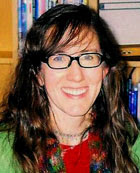 I'm happy today to present a brief interview with Kerry Madden, the author of the brand new book Louisiana's Song. Louisiana's Song is the sequel to Gentle's Holler, which got starred reviews from Kirkus and Publishers Weekly, and was a finalist for the PEN USA Children's Literature Award in 2006.
I'm happy today to present a brief interview with Kerry Madden, the author of the brand new book Louisiana's Song. Louisiana's Song is the sequel to Gentle's Holler, which got starred reviews from Kirkus and Publishers Weekly, and was a finalist for the PEN USA Children's Literature Award in 2006.
I first met Kerry almost exactly a year ago in my hometown of Knoxville, Tennessee. We were both in town to sign and sell books at the Knoxville Festival of Reading on the former site of the 1982 World's Fair. She was gracious enough to join me and Wendi for a late lunch at The Sunspot, where we learned her connection to Knoxville: Kerry first came to our fair city as a teenager when her father was hired as a coach at the University of Tennessee under then Head Coach Johnny Majors, whose tumultuous tenure with the Vols I remember dominating the conversation at every Gratz family gathering for more than two decades. Kerry later attended the University of Tennessee, as did I, and like me still finds herself drawn in to the gravitational pull of East Tennessee even though she now lives in L.A. Given her connections to Tennessee football, I had to throw in a question about her first book, Offsides, even though she's moved on to even greater success with her "Maggie Valley Trilogy" . . .
GI: Give us the thirty-second blurb about your new book, Louisiana's Song, and its place in your Maggie Valley trilogy.
KM: Thirty seconds, Alan? I'm too long-winded with gaps, breaks, and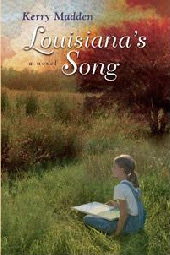 unfinished sentences. . . but here goes: Louisiana's Song is a story of art, auditory hallucinations, music, and family. When Daddy comes home from the Rip Van Winkle Rest Home dramatically different than the daddy the children knew, the kids band together to bring him back to them through murals, flashcards, fairy hunts, and songs. Louisiana "Louise" is the hero despite her terrible shyness - and the story is set against the backdrop of Ghost Town in the Sky, Maggie Valley, and the turbulent history of 1963. (I bet that's longer than 30 seconds.)
unfinished sentences. . . but here goes: Louisiana's Song is a story of art, auditory hallucinations, music, and family. When Daddy comes home from the Rip Van Winkle Rest Home dramatically different than the daddy the children knew, the kids band together to bring him back to them through murals, flashcards, fairy hunts, and songs. Louisiana "Louise" is the hero despite her terrible shyness - and the story is set against the backdrop of Ghost Town in the Sky, Maggie Valley, and the turbulent history of 1963. (I bet that's longer than 30 seconds.)
GI: That's all right. We forgive you. But points will be deducted from your overall score. Now, did you know when you were writing Gentle's Holler that you wanted this to be a three-part story, or did that come later at the request of the publisher?
KM: No, I didn't know it would be a trilogy. I thought I would write a book from each kid's point of view, but Livy Two is the family storyteller and I'm so glad she is the voice of the first three books. (Thank you, wise editors!) Of course, I still have more Weems' stories to tell, but these three books felt right as a Smoky Mountain Trilogy of Maggie Valley stories.
GI: What is the larger story being told by this trilogy?
KM: I think the larger story is family and imagination and longing - I wanted a big messy family who loved art and music and yet had regular squabbles and longed for adventures.
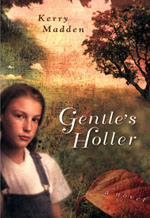 GI: How do you balance telling a larger, three-part story with the need to make each book work as a stand-alone volume?
GI: How do you balance telling a larger, three-part story with the need to make each book work as a stand-alone volume?
KM: Well, I picked three characters I wanted to focus on in each of the books. In Gentle's Holler, the character of Gentle is a huge part of the plot - her eyes - blindness - and the introduction of Uncle Hazard, the dog, who becomes her loyal friend and guide. In Louisiana's Song, I wanted to explore the life of a very tall girl and shy artist who finds her courage and her father, who is lost in his own recovery from the accident. And in Jesse's Mountain, we go back to the 1940s through Mama's diary, her love of birds, and we see the girl she was and how she came to have ten children. So even though Livy Two is our narrator and eavesdropper and plotter, I focused each book on one particular character in the Weems' family. Now I have to decide whether to write more Livy Two stories or write from the point of view of say, Gentle or Caroline or Cyrus or even Jitters - Jitters, though, does get her chance to shine in Jesse's Mountain.
GI: Okay, I can't resist, because I know your connection to UT football. Your first novel, Offsides, was well-reviewed when it came out more than ten years ago. Can you tell us where that story came from, and what happened with that novel?
KM: People have noted Offsides was a lot like The Great Santini, only from the girl's point of view with a football instead of a military backdrop. It was a New York Library Pick for the Teen Age in 1997. The story came from my own life growing up on the gridiron in the world college football, dressing in orange and white, blue and gold, purple and white - and considering myself a Cyclone, Wildcat, Demon Deacon, Volunteer - wherever my dad happened to be coaching. Offsides is the metaphor because Liz Donegal, my alter-ego, is perpetually "offsides" in the world of high-haired coaches wives, locker rooms, Catholic Schools, and constantly moving around from the North to the South to the Midwest - she is swept up in her father's search for the opportunity to win some football games!
Offsides also went through the Hollywood mill, optioned by Jim Henson Productions with Diane Keaton and Bill Robinson of Blue Relief attached to produce and direct. We had meetings in Hollywood for four years - I'm not kidding. It was tossed around as a feature film, a one hour pilot (LIFETIME for a minute), a half-hour sitcom - you name it. We had meetings at Working Title, Jim Henson, ABC, NBC, CBS, Fox Family, Lifetime, UPN, WB . . . every incarnation: can the coach be African American? Could it be the Thursday Night Wives Club? Could it focus on Mom and Dad instead of the kid? Diane Keaton did send me chocolate football - a regular football of solid chocolate - and she came for dinner. Here is an essay about her coming to dinner called "Toys in the Crawlspace" from LA Weekly.
My agent is currently submitting Offsides as a YA novel because it was never published YA, so maybe it will have a new life. (Frankly, I think it needs cutting.)
GI: I hope it finds a second life then! Now, I know that your father's occupational wanderings when you were a child eventually led you to Knoxville, Tennessee, my hometown, and that you attended the University of Tennessee. Your own travels have taken you to Europe and Asia, and you now live on the West Coast. What is it about the mountains of East Tennessee/Western North Carolina that won't let you go? Was it love at first sight, or did the mountains have to win you over?
KM: You're right, Alan. They won't let me go. And I never ever planned for that to happen. I left Knoxville never dreaming I'd look back, and I've spent two decades looking back in one form or another. When I got my driver's license on my sixteenth birthday in Knoxville, my mother handed me the keys and said, "Congratulations. Now go pick up your brothers from football practice." From that day on, I drove everywhere, and when friends would come to town, I would drive them to the mountains. Friends were always stunned by the beauty, and I began to feel proud of the mountains - a tiny claim to them - after an itinerant childhood. I was always searching for home with moving so much and being the new kid. We go back every year - we even found Maggie Valley on a road trip when the kids were tiny. When I began to write Gentle's Holler, I picked the most beautiful place I could think of - the Smoky Mountains. My dream is to live there again and teach at a university and write my novels. I have never felt really like Los Angeles is home - I love our friends and our lives, but it's not home.
GI: Thanks Kerry - we hope you come back to stay. In the meantime, everyone here at Gratz Industries wishes you the best of success with Louisiana's Song!
And hey, we're just the third stop on Kerry's Book Blog Tour this week. Check in on her previous installments at
Elizabeth Dulemba's blog and
Dotti Enderle's blog, then later this week on
Kim Norman's blog on Thursday, and
Ruth McNally Barshaw's blog on Saturday. And go pick up copies of
Gentle's Holler and
Louisiana's Song! Kerry needs bus fare back to Knoxville . . .
THE END
The final 1/4 of the project.
The protagonist now knows what's not working and goes in pursuit of what does.
She is challenged every step of the way, only now in the End, she attempts to react in a new transformed way.
Each scene shows her finding her power little by little.
The Climax
The Climax comes almost at The End of the story itself.
The Climax is the biggest scene in the entire story.
The Climax is what the story is all about.
Each scene in the entire book has worked its way steadily toward this moment ~~ the Climax.
The Climax embodies the transformation.
The Climax shows the protagonist doing something she is now only able to do because of each of the tests and trials she underwent in the middle.
The Resolution
The Resolution is the final tie-up of everything.
The End builds at a fevered pitch to the Climax.
The energy drops off after that.
The Resolution brings final closure.

Ladies and gentlemen, welcome Ruth McNally Barshaw to the Gratz Industries auditorium!
RMB: Ellie's a kid who goes camping with relatives she can't stand and she keeps a sketch diary of it all. It has games, pranks, observations, nature facts, survival skills -- everything but the kitchen sink. Actually, there IS a kitchen sink in it, a camper's sink, which Ellie throws at her cousin. But because it's a kid story, it ends happy. (20 seconds)
GI: Your sketchbooks, many pages of which are posted on your web site at www.ruthexpress.com, are fantastic. Tell us more about them. How long have you been keeping sketchbooks? What sorts of things do you sketch? Do you worry about correcting your art as you work in your sketchbooks?
RMB: Thank you! I've been keeping a regular sketchbook-diary off and on since high school. One of the first is from my trip to Mexico at age 15. My mom made me take slide film for the camera, no print film. So when I wanted to view my photos from the trip it wasn't easy. I was so glad I had the sketchbook, to relive all the cool things that happened.
I sketch all sorts of things. The hardest thing to sketch was a soccer game. Running horses are really hard, too. The saddest thing is funerals; I think I've done 6. Happiest was the birth of my grandson. I started sketching with a pen 17 years ago. My grandpa was in poor health and I started writing him every few days, mostly cartoons of the funny things my kids were doing. Eventually it became cumbersome to sketch in pencil and redraw in ink. It was expedient to just sketch in pen. Scary, but expedient. I still make lots of mistakes. The perfectionist in me sometimes screams in pain at the mistakes. But few artists sketch in ink, and I feel it's a valuable skill, so I keep at it.
GI: Tell us about your experiences sketchbooking at the SCBWI Winter Conference, and how that led to you selling Ellie McDoodle.
RMB: I went to the 2005 conference not knowing where I was going to stay. I was flat broke, took out a loan to get there. I had a strong sense that something important would happen there. But even though Cecilia Yung, Penguin AD and SCBWI Advisory Board member, kept saying to the audience, "If you are great, we will find you," nobody seemed to find me. I sketched it all -- my angst and despair, and also all the many cool things that happened. When I got home I put it all on my website, all 180 pages.
Within days there was a huge buzz: Hundreds of emails arrived, many exhorting me to do a kids' book in that style. It took a while to convince me. I felt my work was not strong enough, or someone would have "found me." But I started the book, and an agent emailed me, all within a week of coming home from the conference. I finished the book as quickly as I could, the agent and I signed together, and she sold my book to Bloomsbury. From conference to sale was 6 months. Almost overnight, my life changed completely.
GI: Tell us about your other cartoon and illustration work. Did you go to school to be an artist? Was illustrating your job before you sold your first children's book? Where has your work appeared?
RMB: I went to Michigan State University to study advertising. I took 2 art courses but felt I didn't fit in with the studio artists so I took other art-like classes in landscape architecture, value engineering and mechanical drawing. I didn't fit in there, either, nor in advertising. I got a job at the newspaper doing comics and ads, then fell into a job with the university doing all kinds of fun promotional stuff. I quit to work out of my home when my (then-) youngest was 3. (She's now 18.) There I bounced around, looking for the right niche. It was an astoundingly frustrating time, mitigated by winning some big money in essay contests with little books.
My work has appeared in all sorts of things related to MSU; stadium cups, apparel, pizza boxes. I've designed a thousand t-shirts, drew caricatures at events, created a few comic strips. Most of my art stayed local, but if you visited a Marriott in California or the Washington DC area, maybe you saw my tourist maps.
A children's cookbook for a hospital was the first job in my life where I went to bed excited from working on it all day and woke up excited to get back to it again. I should have taken that as a clue: Get into kids' books. But, no. It took another 7 years. In the meantime I self-published lots of little books for family and friends. Uncle Charlie's Tasteless Booger Jokes is one of my favorites.
GI: I love your sketches of famous children's authors and illustrators! Have you ever shared your pictures with the writers and artists? If so, what's the best reaction you've ever gotten?
RMB: Thank you! I have shared my pictures with almost all of the writers and artists. They were all gracious and kind, except one who was somewhat dismissive. Maybe I didn't do a good job on that drawing.
The best reaction was Richard Peck, 16 years ago. I drew him at a school district awards luncheon for young writers (I was there because my kid won). He was delighted and promptly gave me his editor's name at Dial, saying I should contact her. I was far too scared and eventually lost the name. How I wish I'd contacted her. And how I wish I still had that drawing. It's around here somewhere. Someday I will meet him again and thank him for his confidence in me at a time when I had none.
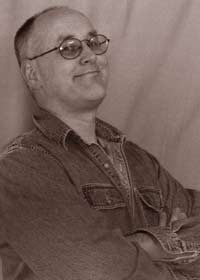 Here at Gratz Industries, we're happy to be part of a Book Blog Tour for a number of authors this summer, beginning with Joe Kulka (left), the author/illustrator of Wolf's Coming. Here are five questions with the wolfman:
Here at Gratz Industries, we're happy to be part of a Book Blog Tour for a number of authors this summer, beginning with Joe Kulka (left), the author/illustrator of Wolf's Coming. Here are five questions with the wolfman:
GI: Give us the twenty-second blurb about Wolf's Crossing.
JK: I think the good folks at Lerner did a fine job summing it up on their website so I'll cheat and paste in their description here:
As a distant howl echoes through the forest, animals quickly stop what they're doing and run for home. Look out - Wolf's coming! As the shadowy figure gets closer and closer and the day draws to a close, the animals shut the door, pull the shades, and turn out the lights. Soon the wolf's glowing eyes appear at the window and the front door opens . . . But things are not as they seem in this suspenseful, clever story, and it's the reader who's in for the biggest surprise of all!
GI: Wolf's Coming is the first picture book you've written and illustrated, but you've illustrated many more books by other authors. Can you tell us more about the collaborative process with authors?
JK: It does vary but most of the time it's pretty much a solo effort. A lot depends on the publisher. Some don't want any direct interaction between author and illustrator. I enjoy initially seeing the manuscript with little to no illustration notes. I like to be able to interpret and, ideally, enhance the text. I%2










 by
by 













Nice, congrats!
congrats on finishing your latest book! Wish I could say the same...
Thanks, Tony.
Cheers, Pat. You'll get there.
Well done, sir. I must dive into my writing hardcore tonight.
Woohoo! Congrats! There's a special kind of thrill that comes with closing a Word file when you know you're DONE!
Huge congrats! I actually love books around 50-60k. Don't get me wrong, I'll take some epic stuff, but I think there's a lot to be said for the short novel -- almost as much as there is to be said for the novella :D